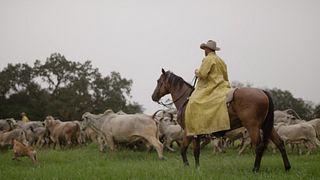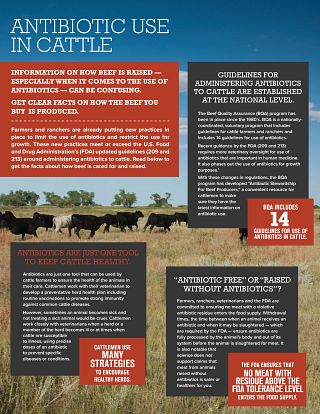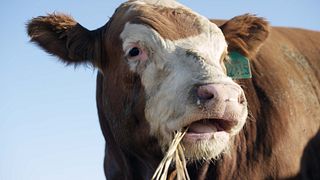Animal Care and the Modern Rancher
Cattle farmers and ranchers have many tools to keep the animals in their care healthy and safe, including nutrition programs, veterinary care, facilities that ensure comfort, and good management practices, such as low-stress handling, vaccines and antibiotics, when necessary. No matter the tool, when it comes to animal health, the practices are science-based, regulated and, above all, good for the animal and the consumer.
How Do Ranchers Keep Cattle Healthy?
Low Stress Handling Methods Continue to Evolve
"We believe that high-quality beef starts with high-quality care, so we follow the Beef Quality Assurance standards when handling cattle, making sure that we move animals quietly and in low-stress ways—and we also educate our employees on proper cattle handling."– Sadie Derstein, Backgrounder, Kismet, Kansas.

How are Antibiotics Used in the Cattle Raising Process?
There has been a great deal of discussion lately about how antibiotics are used in raising livestock. The reality is that farmers and ranchers take antibiotic use in livestock very seriously and continuously evaluate their use based on the best possible science.
Let's explore the role of the antibiotics in animal care.
- Antibiotics are used in animal medicine to prevent, treat, or control disease, which is important to animal and human safety.
- When an animal gets sick, farmers, ranchers and veterinarians carefully evaluate if, and when, to administer antibiotics.
- Cattle farmers and ranchers believe not treating cattle that become sick is inhumane as part of their ongoing commitment to animal health and welfare. When administering antibiotics, they follow product label directions or the prescription provided by their veterinarian, meaning they adhere to usage guidelines to protect both animals and humans that have been rigorously tested and approved by the United States Food & Drug Administration (FDA).
How Are Antibiotics Given to Cattle?
- Depending on the circumstance, antibiotics may be given to cattle as individual injections or added to feed or water to treat a larger group that has been exposed to or to prevent illness.
Are Antibiotics Safe?
- All antibiotics must go through rigorous government scrutiny before being approved for use in livestock.
- Animal medicine goes through three layers of approval to determine if the medicine is safe for the animal, the environment and the humans who will consume the meat. All three areas must be evaluated before approval from the FDA.
- Even after they’re approved, antibiotics are continuously monitored and must be re-evaluated annually. The antibiotics will only stay on the market if they continue to be proven safe.
How are Ranchers Working to Use Antibiotics Responsibly?
- Farmers and ranchers must have authorization from a veterinarian to use antibiotics that are important to human medicine through feed and water and have invested in research and education programs designed to help improve how antibiotics are used.
- Farmers and ranchers have no reason to overuse antibiotics but rather every reason to use them as selectively as possible. Most importantly, responsible use is the right thing to do but furthermore, antibiotics are a costly input for the small business men and women who raise cattle.
- Farmers and ranchers worked with veterinarians and developed guidelines for the judicious use of antibiotics through the Beef Quality Assurance program decades ago. The commitment by cattlemen to responsible antibiotic use continues today with BQA educational resources like “Antibiotic Stewardship for Beef Producers” released in 2016.
"Although the techniques and management practices are continuously improved and updated with the times, the basic premise of raising good quality cattle to make superior quality beef never changes and we’re proud to be a part of that legacy."– Carolyn Geis, Rancher and Veterinarian, Tyndall, South Dakota.
Are there residues from antibiotics in the meat I eat?
- Beef farmers and ranchers, along with veterinarians, are committed to following guidelines to ensure no meat with antibiotic residue above the FDA tolerance level enters our food supply.
- The FDA sets withdrawal times for all veterinary drugs, including antibiotics. Withdrawal time is the amount of time required for the drug to be fully processed by the animal’s body; the withdrawal time depends on the drug but typically ranges from zero to 60 days.
- The USDA randomly tests and monitors beef before it gets to you. By law, no meat sold in the U.S. can contain antibiotic residues above the Maximum Residue Levels (MRLs) set by the FDA to ensure safety.







